You’ve finally done it – you received that big round of funding and you’re ready to say goodbye to your cash-starved bootstrapping days. But with all this new capital comes several hard truths you’ll have to face.
Matt Holleran, General Partner at Cloud Apps Capital Partners, moderates this session led by Kristen Koh Goldstein, CEO and Founder of Scalus. Thanks to her experience founding two companies prior to Scalus and working at fast-growing software companies over the last 20 years, Kristen has a unique perspective on what happens when you stop bootstrapping.
She reinforces the adage to hire slow and fire fast – even if the guilt of letting someone go can crush your soul. As your team grows bigger and bigger, the company culture changes. What was once a tight-knit family turns into a village. Villages need structure, things get harder and the complexity you have to navigate morphs into an immense beast. You’re in for a wild ride, but as founders of SaaS companies, we kinda love that part, don’t we?
Check out the full transcript below!
If you want to see more sessions from SaaStr Annual, we’re releasing a new one each week. Subscribe here to be notified. And be sure to grab your tickets to the next SaaStr Annual NOW.
TRANSCRIPT
Matt Holleran: My name is Matt Holleran, General Partner of Cloud Apps Capital Partners. We lead series A financings in cloud business application companies.
Personally, I spent 12 years in three market leading companies, Clarify, Datasweep, and Salesforce.com, in go-to-market roles from marketing to sales and have 10 years of experience in venture capital and private equity prior to starting Cloud Apps Capital Partners.
It is my honor to introduce Kristen Koh Goldstein, the Founder and CEO of Scalus, a workflow automation platform. Let’s hear it.
[applause]
Matt: She also has experience as an operating executive and as an investor. I think the combined experience over a number of periods and cycles you’ll find helpful here, today.
Her topic is of interest to everyone in this room, which are the 10 things that change when you stop bootstrapping. With that, Kristen.
Kristen Koh Goldstein: Thanks, Matt. Good afternoon, everyone. Thanks so much for being here. As Matt said, I’m the founding CEO of a company called Scalus. This is my third company that I’m founding.
I’ve spent the greater part of the last 20 years as either an early employee, or a founder, or a hired hand CFO of a number of very fast growing software companies. Having sat through hundreds of board meetings, I have a probably different perspective on connecting the dots and understanding what makes a SaaS company successful.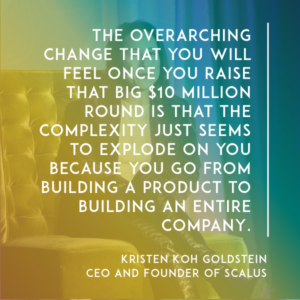
The overarching change that you will feel once you raise that big $10 million round is that the complexity just seems to explode on you because you go from building a product to building an entire company, which is product, people, and process working in concert, in sync.
Having seen this movie before, I’ve been asked a number of times how this cycle is actually different than the last or not. There is definitely a lot of differences, but the biggest one that I see is that during the Internet bubble, it was really more about people people.
Harvard MBAs like myself and Matt descending like locusts down into Silicon Valley, we had these bull of the ocean ideas and started companies with other people people and went into stealth mode. We went and hired as many product people as possible and burned through a lot of money without too much to show for it.
Out of those ashes emerged the Lean startup methodology. We learned a lot from that experience. Today, the environment is a little bit different in that the order of have the 3Ps are executed as changed.
We are seeing a lot more of very frugal and agile product people getting to a minimal viable product really quickly, but then they struggle to build out the team, recruit the people people to graduate out of the one trick pony phase of the transitioning phase of a company, which really will determine your success or failure.
If you can’t emerge out of the one trick pony stage, you will maybe become acqui-hire candidate or not. It’s really important to think about the cycle in terms of the 3Ps. Of course, without the product and people part, process doesn’t matter because there’s no business there for you to scale to make repeatable.
One of the first things that you’ll notice after the big raise is that the mythical man month is real. The faster you try to hire people, the longer it’s actually going to take you to build your business. I know that’s really counter intuitive, but it turns out that building trust in human relationships is a process.
There’s no real manual override button for it. The faster you recruit people, the more chaos there tends to be. There’s a certain percentage of new hires you can have in an organization in any given point before the chaos consumes you and you can’t scale your business.
It’s interesting that the R square to whether or not you can survive that phase is how young your work population is, your employee base, because the younger they are, the more adaptable they are to change, so that actually matters.
This is a hard one. You will learn very quickly that you will gain immediately a second or third job as a recruiter for your business. It’s literally never going to end. You’ll remember that the first and last thing that your VC will tell you as a the $10 million gets wired to you, is that he expects you to spend 80 percent of your time building your team and recruiting for the company.
You’re thinking the whole time, “Oh my God! I’m already working around the clock. If that’s 80 percent of my time, how the heck am I going to continue to iterate on the products to stay competitive and build the business?” You trick yourself into thinking that recruiting is a phase. The sooner you get it over with, the better off you are because then you can go in and do the rest of your job.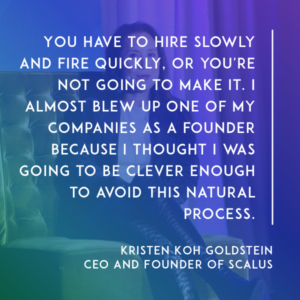
That’s really a mistake because you just can’t, again, hit the manual override button. You have to hire slowly and fire quickly, or you’re not going to make it. I know this from personal experience. I almost blew up one of my companies as a founder because I thought I was going to be clever enough to avoid this natural process.
We had a candidate, who was going to be a transformational hire, a brand name out of a branded startup that scaled to a thousand employees. We managed to hire this person at about the same time we closed this gigantic round from top tier VCs. We did the victory lap around the building, congratulating ourselves. The first 90 days were great, because it’s the honeymoon period. You do a lot of singing around the fireplace, “Kum ba ya.”
As CEO, the next 90 days, you start to think, “Things aren’t happening. This person seems to be paralyzed by big company thinking. What do I do?” You tell yourself, “You’ve got to give the person a chance to be successful.” You spend a lot of time trying to helping them improve. It doesn’t really work.
Then the next 30 to 90 days after that, the third quarter that they are in your payroll, you give up and you try to think of a transition out. You start preparing your team to let this person go. I did this at month seven, and it almost killed us. It was a huge morale hit. We had actually some turnover around it. There’s a loss of confidence.
I just feel lucky having seen this movie before a number of times. I knew better than to acquiesce to his request that I keep him for one full year so that his resume doesn’t look so wrecked, because a lot of first time founders fall into that trap. It’s not really even the salary you’re paying this person for the year. They’re holding the spot of someone who could be executing so you would literally burned a year of cash without much to show for it.
This is why firing fast is really, really hard. It sounds correct academically, but the people side of leading a team will prevent your from being so heartless. The first time that your terminated executive looks at you and shows fear that he can’t pay his mortgage, or tells you that his daughter will now have to drop out of college because he can’t pay her tuition, it’ll crush your soul.
You’ll think about that person for the rest of your life. It’s not any better the second, third, or even the tenth time. It’s something that you have to accept as a founding CEO. This is really hard and really hard to get right but you must do it.
Matt: I agree with you that for everyone in the room, thinking about the right talent and the right people is forever and it’s really hard. I also agree with you that it will never ever and should never be easy to have that hard decision. How about hiring slow? Can you expand on that?
Kristen: Hiring slow was really hard because no one believes mythical man month until they realize it’s real. You really get tricked into believing that the faster you can get through the hiring phase, you can go back to building your product and your business, and you end up hiring way too fast. Then because it was your mistake, you feel bad. You fire really slow. It’s a pretty vicious cycle.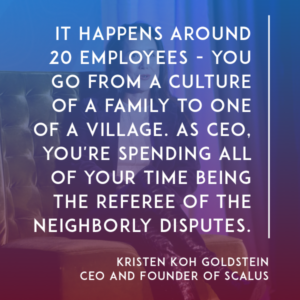
This is also about the time when you raise the big round that you start hiring outside of your circle, which is fraught with risk. I’ll talk a little bit more about that in this slide. It happens around 20 employees. You go from a culture of a family to one of a village. As CEO, you’re spending all of your time being the referee of the neighborly disputes. [laughs]
You end up spending a lot of time trying to maintain what I call battle rhythm, which is essential to success. It’s really hard to define. The best I can describe it is to explain what it feels like when you don’t have battle rhythm, which is that you waste all your gas revving in neutral, going nowhere because your cross functional team is speeding up and slowing down out of sync.
It’s because the culture of the company has changed and you go from an early stage founding team of people who can read each other’s minds, to, “Oh, I have to explain everything now. That’s really hard and it’s slowing me down.”
Again, this process of going from being a family to being a village is a pretty tough transition for most companies to make.
Of course, any sustained period lacking battle rhythm actually sends the company into what I call, the sine wave of death, where the early stage company never quite conquers the inevitable product debt of the early stage before the premature selling hits again.
Then just when you get out from under that debt, the premature selling hits again and the company never just survives. That’s when product development and sales and marketing are totally out of sync as much as they try to be in sync.
Matt: When do you think that you need to start being explicit about culture and really talking about it? Is that something that’s late or early? How do you think about that?
Kristen: Earlier the better. At Scalus, we spent a little over a year being a product organization. Product and operations people live in a state of what I call, pure truth. We just recently hired the entire go to market team and actually sat all the engineers down. We have a fairly young team of engineers, mostly in their 20s.
I had to explain to them, we’re about to invite a whole new cluster of people into our village. They live in a world of aspirational truth. This is why they’re not lying. [laughs] Their job is to see within line of sight, hopefully, not too far, some sales people can see way too far, what should be, and it’s actually their job to make that aspirational truth real truth.
If you burst their bubble, the company will fail. You’d literally have to explain to the engineers, the how people and the product managers, the what people that, although it’s been OK to live in pure truth, we’re now about to emerge into a community of aspirational truth.
It’s important that you explain that or the team won’t gel and there’ll be great distress between the two sides of the house. Struggling to maintain battle rhythm is one of the slow creeps that you really have to conquer at this stage
The other slow creep is that, it’ll be much harder for you to rat out the bus drivers of the organization, because they’ll be disguised as bus builders. In the very early stage, everyone is fiercely entrepreneurial and they are builders playing offense. They live and die by output and results. They’re measured by it. They are proud of it.
You’ll know when you get that first bus driver, because he’ll cry you a river about how hard he’s working, how many hours he’s putting in, and will really insist on being judged by input. The problem is, results are really easy to measure. Efforts really are not.
What you end up doing, if you let this happen, is that you allow politics to enter the company when you just can’t afford politics to be there, because guess what? The entire team will average down to the lowest common denominator. If the guy working hard producing no results is allowed to do what he does, why do I have to work so hard?
This is a really important thing to get right, because it’s a slippery slope down if you don’t rat them out. This one is a doozy. You will wake up one day and then realize you’re actually the biggest problem at your company. What made you so good in the early stages, you’re adaptable, you’re full stack and you jump all over the place fighting fires is exactly what will make your team not successful.
It’s really hard not to be a micromanager, if you keep that style and the team is now many times bigger. Of course, at the same time, the number of hours you’re spending with your team becomes less and less.
Once you raise all this money from VCs, every single investor will want you to spend time with every single person they’ve ever known in their lives, and ask them how they can help your company. You’re spending less and less time with your team. When you actually finally do come back and spend time with them, you’ll be overly critical without context.
You’ll demoralize a team that all over sudden is second guessing themselves. Over time, you become the untrustworthy person, because you’re everywhere and nowhere, and giving them lots of feedback without giving them the opportunity to internalize the feedback.
This is the stage where you realize, wow it’s really hard to systematically and consistently share the information I’m bringing back from the field. This is an especially big problem for introverts like me. What I like to do is look in my own head and process information, and then present what I think.
That doesn’t always work for people who want to be an active participant in that thinking process, which is much more natural to extroverts. This is really hard.
What do you do here? You have to systematically and consistently share information with the team that desperately needs the feedback.
You’ll immediately think about adding more hierarchy to make the information sharing more predictable and less random, and risk bringing too much organization or hierarchy into the organization. You’ll be like Goldielocks. It’s either too little or too less, and both are pretty dangerous and paralyze your team.
If you have too much hierarchy, it’s called politics. You’ll have gatekeepers and information and that doesn’t always end well at this very early stage. So far, you’ve hired outside of your circle. You’re trying really hard not to be a micromanager, which is very hard. You are afraid to add hierarchy, but you need hierarchy.
How do you get all this done? This is when you have to start really thinking about how to bring process into the company to make the success of the initial team repeatable. This is pretty hard.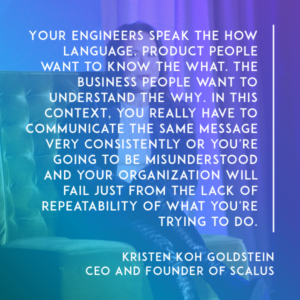
Remember, you’re going from a phase where the founders can operate while reading each other’s minds to actually having to systematically and consistently share information across the board with team members that speak a different language. Again, your engineers speak the how language. They want to know how something is going to work.
They could care less about, the what or the why. Product people want to know the what, every pixel. The business people want to understand the why. In this context, you really have to communicate very consistently the same message or you’re going to be misunderstood, and your organization will fail just from the lack of repeatability of what you’re trying to do.
Your job as the founding CEO at this point is that you have to manage this tension that’s growing between empowering your team to achieve the impossible through inspiration and motivation with the chaos of an increasing number of people on the team trying to determine how things get done. It’s really hard.
You have to somehow motivate a group of people to share best practices which are continually changing in a way that works for everybody. The way I’ve been able to achieve it is to first start with trust. You have to trust the people doing the work that they know how to do it the best. You can’t second guess them.
You can’t micromanage them. Trust comes from the top. Everyone will feel it if you don’t trust. Once you instill that sense of trust on the whole team, you have to make sure sharing the best practices is actually seamless so that the accountability and the visibility is there.
You have faith that the best practices as it morphs is really truly best practices is only under this environment that you’re actually going to be able to grow the business in a systematic way.
Matt: How do you think about this when you’re hiring your first executives, part of the nucleus of your executive team and helping the company to scale?
Kristen: No amount of words can prepare for that type of transition, especially when you’re bringing in the people who…what I call the processizers. As you know, I had to build an entire app to help organizations make the creation of process feel a lot more natural and less confining because the creative members of your team will fight this tooth and nail and tell you how it’s keeping them from innovating.
This is the part that you mentioned. I learned the hard way, I got my butt kicked more than once, that once you get that big raise from institutional investors they expect you to scale the business.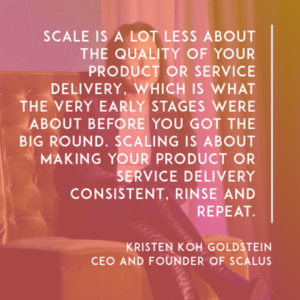
Scale is a lot less about the quality of your product or service delivery, which is what the very early stages were about before you got the big round. Scaling is about making your product or service delivery consistent, rinse and repeat, rinse and repeat, rinse and repeat. If you don’t do that, you don’t have success that’s repeatable or repeating.
You just have a bunch of smart people on a one off fashion creating a business which becomes really a custom dev shop. It’s not anything that’s repeatable.
What do I really mean by scaling? You have to become a metrics driven organization. Again, your creative people will fight it. It turns out it’s really hard to gauge consistency without hard data behind it.
If you don’t have the hard data, you become a political organization. This is the point in time you bring in the executives, the specialists to join the team of generalists that are agile. I call them the processizers.
This is one of the riskiest points of scaling a business, because the processizers tend to be glass half empty people who are successful because they worry about all the things that went wrong in the rear view mirror, and then obsess about what could go wrong in the future.
That type of perspective is oil and water compared to the early stage entrepreneurs who are very positive, anything is possible, and refuse to take off the rosy color glasses. As CEO, your ability to incorporate the processizers that make success repeatable into an organization of creative innovators is really hard to do.
I have not seen a company scale and be successful without this happening. The timing and sequencing of, again, nailing the three Ps product, people and process is pretty important. In my mind, that process is actually called execution. There’s a lot of talk about execution, but this is what it really means. Everyone talks about it in words that aren’t really tangible. This is what it is.
Matt: 10 powerful things that change when you stop bootstrapping, some great challenges and some hard truths shared with this group here today. Are there questions?
Audience Member: Thank you. Very interesting, thanks a lot. A quick question about firing fast, that’s a difficult thing to do. In relatively small teams you’re often dependent on one person. You wish you could fire him, but you’re worried a bit about the effect when you don’t have an alternate for him.
I’ll be happy to hear your thoughts about it, if you sometimes had to wait before you fired fast like you wanted, because you didn’t have an alternate or you just fired and then went on looking for an alternative.
Kristen: The dangerous situation you can get into when you feel held hostage by the person that you want to fire but you can’t fire is that, unless you fire that person, you feel no urgency to replace them. You need that urgency because the name of this game is executing within a window of time.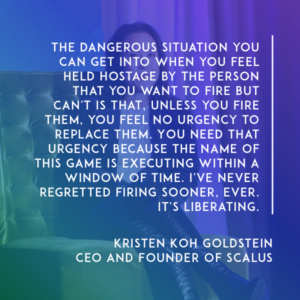
It’s not finite and you’ll lose that window. I learned the hard way that firing fast as fast as you can is actually an imperative to being successful. I’ve never regretted firing sooner, ever. It’s liberating.
Audience Member: Thanks.
Audience Member: Question, over here. Left side, your left side? Over here, way on the side, sorry. [laughs] A lot of the talk or a lot of your talk about scaling included taking a round or taking funding. Do you see this as a necessary step in leaving bootstrapping to scale your company or do you see an organic approach where you literally just fuel it off of sales, just take it until…?
[crosstalk]
Kristen: I believe that you should bootstrap for as long as you possibly can. Then some companies don’t ever need institutional funding. I took one of my companies to three million in revenue at a very high profit margin before I took any money.
I did so primarily for reasons of recruiting. It turns out when you have brands like Google and Sherpa behind you, hiring is a lot easier. That’s really the only reason why I did it.
Matt: Thank you.
Audience Member: Thank you so much. I’m from Atlanta, so a lot of our talent resources obviously are not as prevalent as they are here or a number of other cities across the country. I use Upwork to find a lot of our talent.
What I’m running into now approaching 80 percent of our company being contractors is this awkward cultural issue, where they’re not an employee, but they need to be close enough to the fire where they actually need to understand the direction to do what they do.
How do you handle contractors and the bleed over that you have to get to them when it comes to the culture that you’re trying to build at such an early stage?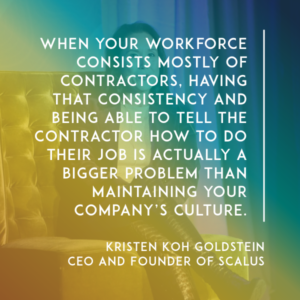
Kristen: Actually, when your workforce consists mostly of contractors, culture is actually not the biggest problem you have. You actually have a much bigger HR problem in that you’re not allowed to tell contractors how to do their job. The consistency in product and service delivery is actually pretty impossible.
When companies like Zirtual and Homejoy went out of business, I got a lot of calls about how it’s possible that BackOps is profitable and thriving. Employees through and through and the accountants on that network literally process known workflows in a task list with videos attached to every task in the task list.
That team has a standard where any smart person could be walked off the street and do the job. It’s really that consistency and being able to tell the contractor how to do their job that’s actually a bigger problem than the culture. I converted right away all the contractors to employees.
Audience Member: Thank you.
Audience Member: As you were talking about firing fast and later on talking about integrating culture as you have to hire different types of people, sounds like there’s a bit of a tension there that you’re going to want to try to get rid of people that are challenging to the growing organization, but you’re also bringing people that are challenging the other people of the organization.
Can you talk a little bit more about reconciling that as you’re growing?
Kristen: I think you’re asking how to manage the turmoil of turnover as you try to build culture and trust, is that correct? I actually have a methodology. I’m a process wonk, where I believe that if you frame a situation in a certain way and include the right stakeholders to have a part in the decision making, it’s the only way that you can operate to instill that level of trust.
Whenever any of my employees come to me with a problem, I literally put them through the same framework. “OK, well let’s make sure we understand the problem to solve and agree. What are our goals to solve this problem? Let’s identify together what are the three options.” We always want three, “As well as the pros, cons, risk and benefits of these three options.”
Believe it or not, the process of going through those options, you all get to the same conclusion at the end. You have buy in, because the entire team of people in the room who needed to be part of that decision heard it. You don’t have the problem with the meeting after the meeting, which is a killer.
Matt: Well please join me in thanking Kristen for sharing these thoughts today.
[applause]
Kristen: Thank you.
You can see Kristen’s slides here.
